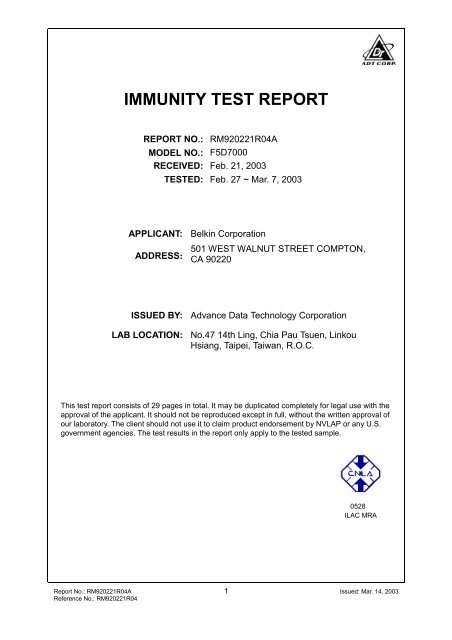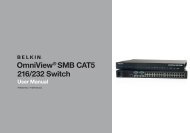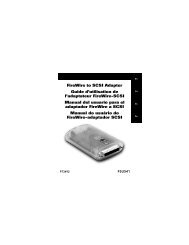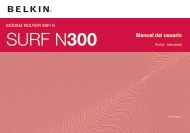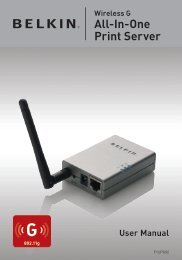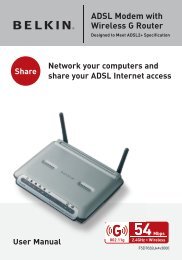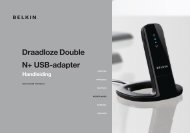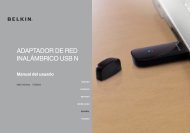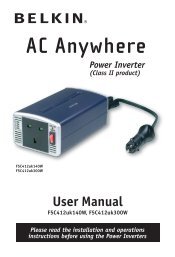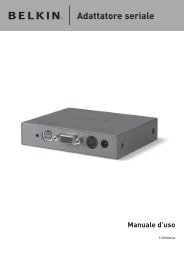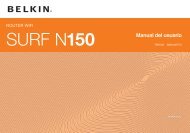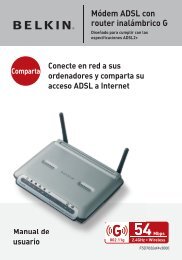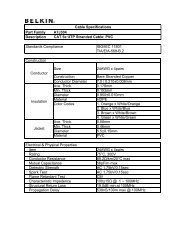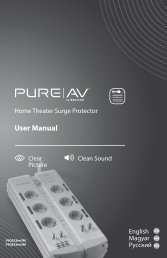IMMUNITY TEST REPORT
IMMUNITY TEST REPORT
IMMUNITY TEST REPORT
You also want an ePaper? Increase the reach of your titles
YUMPU automatically turns print PDFs into web optimized ePapers that Google loves.
<strong>IMMUNITY</strong> <strong>TEST</strong> <strong>REPORT</strong><br />
<strong>REPORT</strong> NO.: RM920221R04A<br />
MODEL NO.: F5D7000<br />
RECEIVED: Feb. 21, 2003<br />
<strong>TEST</strong>ED: Feb. 27 ~ Mar. 7, 2003<br />
APPLICANT: Belkin Corporation<br />
ADDRESS:<br />
501 WEST WALNUT STREET COMPTON,<br />
CA 90220<br />
ISSUED BY: Advance Data Technology Corporation<br />
LAB LOCATION: No.47 14th Ling, Chia Pau Tsuen, Linkou<br />
Hsiang, Taipei, Taiwan, R.O.C.<br />
This test report consists of 29 pages in total. It may be duplicated completely for legal use with the<br />
approval of the applicant. It should not be reproduced except in full, without the written approval of<br />
our laboratory. The client should not use it to claim product endorsement by NVLAP or any U.S.<br />
government agencies. The test results in the report only apply to the tested sample.<br />
0528<br />
ILAC MRA<br />
Report No.: RM920221R04A 1 Issued: Mar. 14, 2003<br />
Reference No.: RM920221R04
Table of Contents<br />
1 CERTIFICATION ..................................................................................................................... 3<br />
2 SUMMARY OF <strong>TEST</strong> RESULTS ............................................................................................ 4<br />
3 GENERAL INFORMATION ..................................................................................................... 5<br />
3.1 GENERAL DESCRIPTION OF EUT ........................................................................................5<br />
3.2 DESCRIPTION OF <strong>TEST</strong> MODE.............................................................................................6<br />
3.3 GENERAL DESCRIPTION OF APPLIED STANDARD ...........................................................6<br />
3.4 DESCRIPTION OF SUPPORT UNIT.......................................................................................7<br />
4 EMISSION <strong>TEST</strong>..................................................................................................................... 8<br />
4.1 CONDUCTED EMISSION MEASUREMENT ..........................................................................8<br />
4.1.1 LIMITS OF CONDUCTED EMISSION MEASUREMENT........................................................8<br />
4.1.2 <strong>TEST</strong> INSTRUMENTS .............................................................................................................8<br />
4.1.3 <strong>TEST</strong> PROCEDURES..............................................................................................................9<br />
4.1.4 DEVIATION FROM <strong>TEST</strong> STANDARD....................................................................................9<br />
4.1.5 <strong>TEST</strong> SETUP .........................................................................................................................10<br />
4.1.6 EUT OPERATING CONDITIONS ..........................................................................................10<br />
4.1.7 <strong>TEST</strong> RESULTS.....................................................................................................................11<br />
5 <strong>IMMUNITY</strong> <strong>TEST</strong> ..................................................................................................................13<br />
5.1 GENERAL DESCRIPTION ....................................................................................................13<br />
5.2 GENERAL PERFORMANCE CRITERIA DESCRIPTION .....................................................13<br />
5.3 EUT OPERATING CONDITION.............................................................................................15<br />
5.4 ELECTROSTATIC DISCHARGE <strong>IMMUNITY</strong> <strong>TEST</strong> (ESD) ...................................................16<br />
5.4.1 <strong>TEST</strong> SPECIFICATION..........................................................................................................16<br />
5.4.2 <strong>TEST</strong> INSTRUMENT .............................................................................................................16<br />
5.4.3 <strong>TEST</strong> PROCEDURE ..............................................................................................................17<br />
5.4.4 DEVIATION FROM <strong>TEST</strong> STANDARD..................................................................................17<br />
5.4.5 <strong>TEST</strong> SETUP .........................................................................................................................18<br />
5.4.6 <strong>TEST</strong> RESULT .......................................................................................................................19<br />
5.5 RADIATED, RADIO-FREQUENCY, ELECTROMAGNETIC FIELD <strong>IMMUNITY</strong> <strong>TEST</strong> (RS) .21<br />
5.5.1 <strong>TEST</strong> SPECIFICATION .........................................................................................................21<br />
5.5.2 <strong>TEST</strong> INSTRUMENT .............................................................................................................21<br />
5.5.3 <strong>TEST</strong> PROCEDURE ..............................................................................................................22<br />
5.5.4 DEVIATION FROM <strong>TEST</strong> STANDARD..................................................................................22<br />
5.5.5 <strong>TEST</strong> SETUP .........................................................................................................................23<br />
5.5.6 <strong>TEST</strong> RESULT .......................................................................................................................24<br />
6 PHOTOGRAPHS OF THE <strong>TEST</strong> CONFIGURATION........................................................... 26<br />
7 APPENDIX - INFORMATION ON THE <strong>TEST</strong>ING LABORATORIES.................................... 29<br />
Report No.: RM920221R04A 2 Issued: Mar. 14, 2003<br />
Reference No.: RM920221R04
1 CERTIFICATION<br />
PRODUCT: 2.4GHz wireless PCI<br />
MODEL NO: F5D7000<br />
BRAND NAME: Belkin<br />
APPLICANT: Belkin Corporation<br />
STANDARDS: EN 301 489-1 (09-2001), EN 301 489-17 (09-2000)<br />
EN 55022:1998, Class B<br />
EN 61000-4-2:1995<br />
EN 61000-4-3:1995<br />
We, Advance Data Technology Corporation, hereby certify that one sample of the<br />
designation has been tested in our facility from Feb. 27 ~ Mar. 7, 2003. The test<br />
record, data evaluation and Equipment Under Test (EUT) configurations represented<br />
herein are true and accurate accounts of the measurements of the sample's immunity<br />
characteristics under the conditions herein specified.<br />
Report No.: RM920221R04A 3 Issued: Mar. 14, 2003<br />
Reference No.: RM920221R04
2 SUMMARY OF <strong>TEST</strong> RESULTS<br />
The EUT has been tested according to the following specifications:<br />
EMISSION<br />
Standard Test Type Result Remarks<br />
EN 55022:1998,<br />
Class B (Conducted<br />
Emission)<br />
EN 61000-3-2:1995<br />
+A1:1998+A2:1998, Class<br />
A<br />
EN 61000-3-3:1995<br />
Conducted Test PASS<br />
Meet the requirement of limit<br />
Minimum passing margin is<br />
–23.49dBuV/m at 0.255MHz<br />
Radiated Test NA NOT APPLICABLE<br />
Harmonic current<br />
emissions<br />
Voltage fluctuations &<br />
flicker<br />
<strong>IMMUNITY</strong><br />
NA NOT APPLICABLE<br />
NA NOT APPLICABLE<br />
Standard Test Type Result Remarks<br />
EN 61000-4-2:1995<br />
EN 61000-4-3:1995<br />
EN 61000-4-4:1995<br />
Electrostatic discharge<br />
immunity test<br />
Radiated, radiofrequency,<br />
electromagnetic field<br />
immunity test<br />
Electrical fast transient<br />
/ burst immunity test.<br />
PASS<br />
PASS<br />
Meets the requirements of<br />
Performance Criterion A<br />
Meets the requirements of<br />
Performance Criterion A<br />
NA NOT APPLICABLE<br />
EN 61000-4-5:1995 Surge immunity test NA NOT APPLICABLE<br />
EN 61000-4-6:1996<br />
EN 61000-4-11:1994<br />
Immunity to conducted<br />
disturbances, induced<br />
by radio-frequency<br />
fields<br />
Voltage dips, short<br />
interruptions and<br />
voltage variations<br />
immunity tests<br />
NOTE: Please refer to Item 3.3 for more detailed description.<br />
NA NOT APPLICABLE<br />
NA NOT APPLICABLE<br />
Report No.: RM920221R04A 4 Issued: Mar. 14, 2003<br />
Reference No.: RM920221R04
3 GENERAL INFORMATION<br />
3.1 GENERAL DESCRIPTION OF EUT<br />
PRODUCT 2.4GHz wireless PCI<br />
MODEL NO. F5D7000<br />
POWER SUPPLY 3.3VDC from host equipment<br />
MODULATION TYPE DSSS, OFDM<br />
TRANSFER RATE Up to 54Mbps<br />
OPERATING<br />
FREQUENCY<br />
NUMBER OF CHANNEL 13<br />
CHANNEL SPACING 5 MHz<br />
RATED RF OUTPUT<br />
POWER LEVEL<br />
2.412GHz ~ 2.472GHz<br />
ANTENNA TYPE Dipole Antenna<br />
DATA CABLE NA<br />
I/O PORTS NA<br />
ASSOCIATED DEVICES NA<br />
18.69dBm (Measured Max. Average)<br />
22.87dBm (Measured Max. Peak))<br />
NOTE: For a more detailed features description, please refer to the manufacturer's specifications<br />
or User's Manual.<br />
Report No.: RM920221R04A 5 Issued: Mar. 14, 2003<br />
Reference No.: RM920221R04
.<br />
3.2 DESCRIPTION OF <strong>TEST</strong> MODE<br />
The EUT was tested under following conditions:<br />
CONDITION CONFIGURATION REMARKS<br />
1 Transmission<br />
2 Standby<br />
3.3 GENERAL DESCRIPTION OF APPLIED STANDARD<br />
The EUT is a kind of computer peripheral with wireless data transmission function.<br />
According to the specifications of the manufacturer, it must comply with the<br />
requirements of the following standards:<br />
EN 301 489-1 (09-2001), EN 301 489-17 (09-2001)<br />
EN 55022:1998, Class B (Conducted Emission)<br />
EN 61000-4-2:1995<br />
EN 61000-4-3:1995<br />
According to clause 7.1 (table 2) and clause 7.2 (table 3) of EN 301 489-1 (09-2001),<br />
all tests have been performed and recorded as per the above standards.<br />
Report No.: RM920221R04A 6 Issued: Mar. 14, 2003<br />
Reference No.: RM920221R04
3.4 DESCRIPTION OF SUPPORT UNIT<br />
The EUT has been tested as an independent unit together with other necessary<br />
accessories or support units. The following support units or accessories were used to<br />
form a representative test configuration during the tests.<br />
For Conducted Emission<br />
NO. PRODUCT BRAND MODEL NO. SERIAL NO. FCC ID<br />
1 PERSONAL<br />
COMPUTER<br />
HP DTPC-16 NA FCC DOC APPROVED<br />
2 MONITOR ADI CM100 020058T102001<br />
82<br />
FCC DOC APPROVED<br />
3 PS/2 KEYBOARD BTC 5121W A00800777 E5XKB5121WTH0110<br />
4 PS/2 MOUSE LOGITECH M-S61 HCA12605710 JNZ211403<br />
5 MODEM ACEEX 1414 980020539 IFAXDM1414<br />
6 PRINTER EPSON LQ-300+ DCGY017059 FCC DOC APPROVED<br />
NO. SIGNAL CABLE DESCRIPTION OF THE ABOVE SUPPORT UNITS<br />
1 NA<br />
2 1.8 m braid shielded wire, terminated with VGA connector via metallic frame, w/o core<br />
3 1.6 m foil shielded wire, terminated with PS/2 connector via metallic frame, w/o core.<br />
4 1.8 mNon shielded wire, terminated with PS/2 connector via drain wire, w/o core.<br />
5 1.2 m braid shielded wire, terminated with DB25 and DB9 connector via metallic frame, w/o<br />
core.<br />
6 1.2m braid shielded wire, terminated with DB25 and Centronics connector via metallic<br />
frame, w/o core<br />
For EMS<br />
NO. PRODUCT BRAND MODEL NO. SERIAL NO. FCC ID<br />
1 PERSONAL<br />
COMPUTER<br />
HP DTPC-16 NA FCC DOC APPROVED<br />
2 MONITOR DELL E772f NA NA<br />
3 PS/2 KEYBOARD HP 6511-PK 99P468101CY1<br />
W06S012293<br />
FCC DOC APPROVED<br />
4 PS/2 MOUSE HP M-S48a LZE11308376AW JNZ201213<br />
5 MODEM GVC F-1128V1R6 96-191-113003 DK4F1128VR6<br />
6 PRINTER HP 2225C 2931S53817 DSI6XU2225<br />
7 ACCESS POINT D-Link DWL-2000AP NA NA<br />
NO. SIGNAL CABLE DESCRIPTION OF THE ABOVE SUPPORT UNITS<br />
1 NA<br />
2 1.8 m braid shielded wire, terminated with VGA connector via metallic frame, with core<br />
3 1.8 m foil shielded wire, terminated with PS/2 connector via metallic frame, w/o core<br />
4 1.8 m Non shielded wire, terminated with PS/2 connector via drain wire, w/o core.<br />
5 1.2 m braid shielded wire, terminated with DB25 and DB9 connector via metallic frame,<br />
w/o core.<br />
6 1.2m braid shielded wire, terminated with DB25 and Centronics connector via metallic<br />
frame, w/o core.<br />
7 NA<br />
NOTE: All power cords of the above support units are non shielded (1.8m).<br />
Report No.: RM920221R04A 7 Issued: Mar. 14, 2003<br />
Reference No.: RM920221R04
4 EMISSION <strong>TEST</strong><br />
4.1 CONDUCTED EMISSION MEASUREMENT<br />
4.1.1 LIMITS OF CONDUCTED EMISSION MEASUREMENT<br />
Class A (dBuV) Class B (dBuV)<br />
FREQUENCY (MHz) Quasi-peak Average Quasi-peak Average<br />
0.15 - 0.5 79 66 66 - 56 56 - 46<br />
0.50 - 5.0 73 60 56 46<br />
5.0 - 30.0 73 60 60 50<br />
NOTE: (1) The lower limit shall apply at the transition frequencies.<br />
(2) The limit decreases in line with the logarithm of the frequency in the range of 0.15<br />
to 0.50 MHz.<br />
(3) All emanations from a class A/B digital device or system, including any network of<br />
conductors and apparatus connected thereto, shall not exceed the level of field<br />
strengths specified above.<br />
4.1.2 <strong>TEST</strong> INSTRUMENTS<br />
DESCRIPTION & MANUFACTURER MODEL NO. SERIAL NO. CALIBRATED UNTIL<br />
ROHDE & SCHWARZ Test Receiver ESHS30 828109/007 July 03, 2003<br />
ROHDE & SCHWARZ Artificial<br />
Mains Network (for EUT)<br />
ESH3-Z5 839135/006 July 02. 2003<br />
* ROHDE & SCHWARZ<br />
4-wire ISN<br />
* ROHDE & SCHWARZ<br />
2-wire ISN<br />
ENY41 838119/028 Nov. 29, 2003<br />
ENY22 837497/016 Nov. 29, 2003<br />
EMCO-L.I.S.N. (for peripheral) 3825/2 9204-1964 July 02, 2003<br />
Software Cond-V2M1 NA NA<br />
RF cable (JYEBAO) 5D-FB Cable-C02.01 July 5, 2003<br />
HP Terminator (For EMCO LISN) 11593A E1-01-298 Feb. 23, 2004<br />
HP Terminator (For EMCO LISN) 11593A E1-01-299 Feb. 23, 2004<br />
NOTE: 1. The calibration interval of the above test instruments is 12 months and the<br />
calibrations are traceable to NML/ROC and NIST/USA.<br />
2. “*”: These equipment are used for conducted telecom port test only (if tested).<br />
3. The test was performed in ADT Shielded Room No. 2.<br />
4. The VCCI Site Registration No. is C-240.<br />
Report No.: RM920221R04A 8 Issued: Mar. 14, 2003<br />
Reference No.: RM920221R04
4.1.3 <strong>TEST</strong> PROCEDURES<br />
a. The EUT was placed 0.4 meters from the conducting wall of the shielded room<br />
with EUT being connected to the power mains through a line impedance<br />
stabilization network (LISN). Other support units were connected to the power<br />
mains through another LISN. The two LISNs provide 50 ohm/ 50uH of coupling<br />
impedance for the measuring instrument.<br />
b. Both lines of the power mains connected to the EUT were checked for maximum<br />
conducted interference.<br />
c. The frequency range from 150 kHz to 30 MHz was searched. Emission levels<br />
over 10dB under the prescribed limits could not be reported<br />
4.1.4 DEVIATION FROM <strong>TEST</strong> STANDARD<br />
No deviation<br />
Report No.: RM920221R04A 9 Issued: Mar. 14, 2003<br />
Reference No.: RM920221R04
4.1.5 <strong>TEST</strong> SETUP<br />
For the actual test configuration, please refer to the related item – Photographs of the<br />
Test Configuration.<br />
4.1.6 EUT OPERATING CONDITIONS<br />
a. Connected the EUT to a computer system placed on a testing table.<br />
b. The computer system ran a test program to enable EUT under<br />
transmission/receiving condition continuously at specific channel<br />
frequency.<br />
c. The computer system sent "H" messages to its screen.<br />
d. The computer system sent “H” messages to modem.<br />
e. The computer system sent "H" messages to printer and the printer prints<br />
them on paper.<br />
Report No.: RM920221R04A 10 Issued: Mar. 14, 2003<br />
Reference No.: RM920221R04
4.1.7 <strong>TEST</strong> RESULTS<br />
EUT 2.4GHz wireless PCI Model F5D7000<br />
INPUT POWER 230Vac, 50 Hz<br />
ENVIRONMENTAL<br />
CONDITIONS<br />
22 deg. C, 68 % RH,<br />
1005 hPa<br />
6dB BANDWIDTH 10 kHz<br />
PHASE Line (L)<br />
<strong>TEST</strong>ED BY: Cody Chang<br />
Freq. Corr. Reading Value<br />
Emission<br />
Level<br />
Limit Margin<br />
No Factor [dB (uV)] [dB (uV)] [dB (uV)] (dB)<br />
[MHz] (dB) Q.P. AV. Q.P. AV. Q.P. AV. Q.P. AV.<br />
1 0.255 0.10 33.16 - 33.26 - 61.59 51.59 -28.33 -<br />
2 0.385 0.10 29.89 - 29.99 - 58.17 48.17 -28.18 -<br />
3 0.767 0.10 26.86 - 26.96 - 56.00 46.00 -29.04 -<br />
4 0.894 0.10 27.21 - 27.31 - 56.00 46.00 -28.69 -<br />
5 1.402 0.10 29.45 - 29.55 - 56.00 46.00 -26.45 -<br />
6 7.103 0.46 26.08 - 26.54 - 60.00 50.00 -33.46 -<br />
REMARKS:<br />
1. Q.P. and AV. are abbreviations of quasi-peak and average individually.<br />
2. "-": The Quasi-peak reading value also meets average limit and measurement with<br />
the average detector is unnecessary.<br />
3. The emission levels of other frequencies were very low against the limit.<br />
4. Margin value = Emission level - Limit value<br />
5. Correction factor = Insertion loss + Cable loss<br />
6. Emission Level = Correction Factor + Reading Value.<br />
Report No.: RM920221R04A 11 Issued: Mar. 14, 2003<br />
Reference No.: RM920221R04
EUT 2.4GHz wireless PCI Model F5D7000<br />
INPUT POWER 230Vac, 50 Hz<br />
ENVIRONMENTAL<br />
CONDITIONS<br />
22 deg. C, 68 % RH,<br />
1005 hPa<br />
6dB BANDWIDTH 10 kHz<br />
PHASE Neutral (N)<br />
<strong>TEST</strong>ED BY: Cody Chang<br />
Freq. Corr. Reading Value<br />
Emission<br />
Level<br />
Limit Margin<br />
No Factor [dB (uV)] [dB (uV)] [dB (uV)] (dB)<br />
[MHz] (dB) Q.P. AV. Q.P. AV. Q.P. AV. Q.P. AV.<br />
1 0.255 0.10 38.00 - 38.10 - 61.59 51.59 -23.49 -<br />
2 0.384 0.10 33.92 - 34.02 - 58.19 48.19 -24.17 -<br />
3 0.768 0.10 26.09 - 26.19 - 56.00 46.00 -29.81 -<br />
4 0.894 0.10 28.17 - 28.27 - 56.00 46.00 -27.73 -<br />
5 1.404 0.10 29.69 - 29.79 - 56.00 46.00 -26.21 -<br />
6 7.427 0.36 28.20 - 28.56 - 60.00 50.00 -31.44 -<br />
REMARKS:<br />
1. Q.P. and AV. are abbreviations of quasi-peak and average individually.<br />
2. "-": The Quasi-peak reading value also meets average limit and measurement with the<br />
average detector is unnecessary.<br />
3. The emission levels of other frequencies were very low against the limit.<br />
4. Margin value = Emission level - Limit value<br />
5. Correction factor = Insertion loss + Cable loss<br />
6. Emission Level = Correction Factor + Reading Value.<br />
Report No.: RM920221R04A 12 Issued: Mar. 14, 2003<br />
Reference No.: RM920221R04
5 <strong>IMMUNITY</strong> <strong>TEST</strong><br />
5.1 GENERAL DESCRIPTION<br />
Product<br />
Standard<br />
Basic Standard,<br />
Specification, and<br />
Performance<br />
Criterion required<br />
EN 301 489-1 (09-2001), EN 301 489-17 (09-2000)<br />
EN 61000-4-2 Electrostatic Discharge – ESD:<br />
8kV air discharge, 4kV Contact discharge,<br />
Performance Criterion B<br />
EN 61000-4-3 Radio-Frequency Electromagnetic Field<br />
Susceptibility Test – RS:<br />
80-1000 / 1400-2000 MHz, 3V/m, 80% AM (1kHz),<br />
Performance Criterion A<br />
5.2 GENERAL PERFORMANCE CRITERIA DESCRIPTION<br />
1<br />
2<br />
3<br />
4<br />
The Requirement of Performance Criteria<br />
Performance criteria for<br />
continuous phenomena applied<br />
to transmitters (CT)<br />
Performance criteria for<br />
transient phenomena applied to<br />
transmitters (TT)<br />
Performance criteria for<br />
continuous phenomena applied<br />
to receivers (CR)<br />
Performance criteria for<br />
transient phenomena applied to<br />
receivers (TR)<br />
Criterion A of the applicable class shall apply<br />
Criterion B of the applicable class shall apply<br />
Criterion A of the applicable class shall apply<br />
Criterion B of the applicable class shall apply<br />
Report No.: RM920221R04A 13 Issued: Mar. 14, 2003<br />
Reference No.: RM920221R04
The phenomena allowed during and after test in each criterion are clearly stated in<br />
the following table<br />
Performance criteria<br />
Criteria During test After test<br />
A<br />
B<br />
C<br />
Shall operate as intended.<br />
May show degradation of<br />
performance (see note1).<br />
Shall be no loss of function.<br />
Shall be no unintentional<br />
transmissions.<br />
May show loss of function (one or<br />
more).<br />
May show degradation of<br />
performance (see note 1).<br />
No unintentional transmissions.<br />
Shall operate as intended.<br />
Shall be no degradation of<br />
performance (see note 2).<br />
Shall be no loss of function.<br />
Shall be no loss of stored data or<br />
user programmable functions.<br />
Functions shall be selfrecoverable.<br />
Shall operate as intended after<br />
recovering.<br />
Shall be no degradation of<br />
performance (see note 2).<br />
Shall be no loss of stored data or<br />
user programmable functions.<br />
May be loss of function (one or more). Functions shall be recoverable<br />
by the operator.<br />
Shall operate as intended after<br />
recovering.<br />
Shall be no degradation of<br />
performance (see note 2).<br />
NOTE 1:Degradation of performance during the test is understood as a degradation to a level<br />
not below a minimum performance level specified by the manufacturer for the use of<br />
the apparatus as intended. In some cases the specified minimum performance level<br />
may be replaced by a permissible degradation of performance.<br />
If the minimum performance level or the permissible performance degradation is not<br />
specified by the manufacturer then either of these may be derived from the product<br />
description and documentation (including leaflets and advertising) and what the user<br />
may reasonably expect from the apparatus if used as intended.<br />
NOTE 2: No degradation of performance after the test is understood as no degradation below a<br />
minimum performance level specified by the manufacturer for the use of the<br />
apparatus as intended. In some cases the specified minimum performance level may<br />
be replaced by a permissible degradation of performance. After the test no change of<br />
actual operating data or user retrievable data is allowed.<br />
If the minimum performance level or the permissible performance degradation is not<br />
specified by the manufacturer then either of these may be derived from the product<br />
description and documentation (including leaflets and advertising) and what the user<br />
may reasonably expect form the apparatus if used as intended.<br />
Report No.: RM920221R04A 14 Issued: Mar. 14, 2003<br />
Reference No.: RM920221R04
5.3 EUT OPERATING CONDITION<br />
1. Connected the EUT to a computer system placed on a testing table.<br />
2. The computer system ran a test program to enable all functions of EUT.<br />
3. Prepared the access point and placed it outside of testing area to act as<br />
communication partner for EUT.<br />
4. Sent data to EUT by command "PIN" from the communication partner.<br />
Note: For standby mode test, connected a coupling antenna to a spectrum analyzer and placed the<br />
antenna near the EUT to monitor any unintentional response occurring from the EUT during the test.<br />
Report No.: RM920221R04A 15 Issued: Mar. 14, 2003<br />
Reference No.: RM920221R04
5.4 ELECTROSTATIC DISCHARGE <strong>IMMUNITY</strong> <strong>TEST</strong> (ESD)<br />
5.4.1 <strong>TEST</strong> SPECIFICATION<br />
Basic Standard: EN 61000-4-2<br />
Discharge Impedance: 330 ohm / 150 pF<br />
Discharge Voltage: Air Discharge - 8 kV (Direct)<br />
Contact Discharge – 4kV (Direct/Indirect)<br />
Polarity: Positive & Negative<br />
Number of Discharge: Minimum 20 times at each test point<br />
Discharge Mode: Single Discharge<br />
Discharge Period: 1 second minimum<br />
5.4.2 <strong>TEST</strong> INSTRUMENT<br />
DESCRIPTION &<br />
MANUFACTURER<br />
MODEL NO. SERIAL NO. CALIBRATED<br />
UNTIL<br />
KeyTek, ESD Simulator MZ-15/EC 9902287 Feb. 26, 2003<br />
EM Test ESD Simulator ESD 30C 0201-28 Jul. 15, 2003<br />
EM Test ESD Discharge Unit P30C 0201-28 Jul. 15, 2003<br />
EM Test ESD Discharge Unit P30C-RFCI 0601-07 Jul. 15, 2003<br />
FCC Coupling Decoupling<br />
Network<br />
FCC Coupling Decoupling<br />
Network<br />
FCC-801-T2 020022 Jun.12, 2003<br />
FCC-801-T4 020033 Jun.12, 2003<br />
NOTE: 1. The test was performed in ESD Room No. 1.<br />
2. The calibration interval of the above test instruments is 12 months and the<br />
calibrations are traceable to NML/ROC and NIST/USA.<br />
Report No.: RM920221R04A 16 Issued: Mar. 14, 2003<br />
Reference No.: RM920221R04
5.4.3 <strong>TEST</strong> PROCEDURE<br />
a. Electrostatic discharges were applied only to those points and surfaces of the<br />
EUT that are accessible to users during normal operation.<br />
b. The test was performed with at least ten single discharges on the pre-selected<br />
points in the most sensitive polarity.<br />
c. The time interval between two successive single discharges was at least 1<br />
second.<br />
d. The ESD generator was held perpendicularly to the surface to which the<br />
discharge was applied and the return cable was at least 0.2 meters from the<br />
EUT.<br />
e. Contact discharges were applied to the non-insulating coating, with the pointed<br />
tip of the generator penetrating the coating and contacting the conducting<br />
substrate.<br />
f. Air discharges were applied with the round discharge tip of the discharge<br />
electrode approaching the EUT as fast as possible (without causing<br />
mechanical damage) to touch the EUT. After each discharge, the ESD<br />
generator was removed from the EUT and re-triggered for a new single<br />
discharge. The test was repeated until all discharges were complete.<br />
g. At least ten single discharges (in the most sensitive polarity) were applied to<br />
the Horizontal Coupling Plane at points on each side of the EUT. The ESD<br />
generator was positioned vertically at a distance of 0.1 meters from the EUT<br />
with the discharge electrode touching the HCP.<br />
h. At least ten single discharges (in the most sensitive polarity) were applied to<br />
the center of one vertical edge of the Vertical Coupling Plane in sufficiently<br />
different positions that the four faces of the EUT were completely illuminated.<br />
The VCP (dimensions 0.5m x 0.5m) was placed vertically to and 0.1 meters<br />
from the EUT.<br />
5.4.4 DEVIATION FROM <strong>TEST</strong> STANDARD<br />
No deviation<br />
Report No.: RM920221R04A 17 Issued: Mar. 14, 2003<br />
Reference No.: RM920221R04
5.4.5 <strong>TEST</strong> SETUP<br />
PP SS<br />
PP SS<br />
1m<br />
ESD<br />
Generator<br />
Nearest<br />
Wall Horizontal<br />
coupling plane<br />
EUT<br />
Reference Ground Plane<br />
Vertical<br />
coupling plane<br />
0.5mm Isolation Support<br />
Report No.: RM920221R04A 18 Issued: Mar. 14, 2003<br />
Reference No.: RM920221R04<br />
0.1m<br />
80cm<br />
470k<br />
X4<br />
For the actual test configuration, please refer to the related item – Photographs of the<br />
Test Configuration.<br />
NOTE:<br />
TABLE-TOP EQUIPMENT<br />
The configuration consisted of a wooden table 0.8 meters high standing on the Ground Reference<br />
Plane. The GRP consisted of a sheet of aluminum at least 0.25mm thick, and 2.5 meters square<br />
connected to the protective grounding system. A Horizontal Coupling Plane (1.6m x 0.8m) was placed<br />
on the table and attached to the GRP by means of a cable with 940kΩ total impedance. The equipment<br />
under test, was installed in a representative system as described in section 7 of EN 61000-4-2:1995,<br />
and its cables were placed on the HCP and isolated by an insulating support of 0.5mm thickness. A<br />
distance of 1-meter minimum was provided between the EUT and the walls of the laboratory and any<br />
other metallic structure.
5.4.6 <strong>TEST</strong> RESULT<br />
EUT 2.4GHz wireless PCI MODEL NO. F5D7000<br />
MODE Transmission<br />
ENVIRONMENTAL<br />
CONDITIONS<br />
23 deg.C, 47 % RH<br />
1005 hPa<br />
INPUT POWER<br />
(SYSTEM)<br />
230Vac, 50 Hz<br />
<strong>TEST</strong>ED BY: Cody Chang<br />
<strong>TEST</strong> RESULTS OF DIRECT APPLICATION<br />
Discharge<br />
Level (kV)<br />
Polarity<br />
(+/-)<br />
Test Point<br />
Contact<br />
Discharge<br />
Air Discharge<br />
Performance<br />
Criterion<br />
2, 4 +/- 1, 2 NOTE NA A<br />
2, 4, 8 +/- 3 NA NOTE A<br />
Description of test point:<br />
1.breaket 2. Metal of Antenna connector 3.Antenna<br />
Discharge<br />
Level (kV)<br />
<strong>TEST</strong> RESULTS OF INDIRECT APPLICATION<br />
Polarity<br />
(+/-)<br />
Test Point<br />
Horizontal<br />
Coupling Plane<br />
Vertical<br />
Coupling<br />
Plane<br />
Performance<br />
Criterion<br />
2, 4 +/- 1 ~ 4 NOTE NOTE A<br />
Description of test point:<br />
1. Front side 2. Rear side 3. Right side 4. Left side<br />
NOTE:<br />
There was no change compared with the initial operation during and after the test. No unintentional<br />
response was found during the test.<br />
Report No.: RM920221R04A 19 Issued: Mar. 14, 2003<br />
Reference No.: RM920221R04
EUT 2.4GHz wireless PCI MODEL NO. F5D7000<br />
MODE Standby<br />
ENVIRONMENTAL<br />
CONDITIONS<br />
23 deg.C, 47 % RH<br />
1005 hPa<br />
INPUT POWER<br />
(SYSTEM)<br />
230Vac, 50 Hz<br />
<strong>TEST</strong>ED BY: Cody Chang<br />
<strong>TEST</strong> RESULTS OF DIRECT APPLICATION<br />
Discharge<br />
Level (kV)<br />
Polarity<br />
(+/-)<br />
Test Point<br />
Contact<br />
Discharge<br />
Air Discharge<br />
Performance<br />
Criterion<br />
2, 4 +/- 1, 2 NOTE NA A<br />
2, 4, 8 +/- 3 NA NOTE A<br />
Description of test point:<br />
1.breaket 2. Metal of Antenna connector 3.Antenna<br />
Discharge<br />
Level (kV)<br />
<strong>TEST</strong> RESULTS OF INDIRECT APPLICATION<br />
Polarity<br />
(+/-)<br />
Test Point<br />
Horizontal<br />
Coupling Plane<br />
Vertical<br />
Coupling<br />
Plane<br />
Performance<br />
Criterion<br />
2, 4 +/- 1 ~ 4 NOTE NOTE A<br />
Description of test point:<br />
1. Front side 2. Rear side 3. Right side 4. Left side<br />
NOTE:<br />
There was no change compared with the initial operation during and after the test. No unintentional<br />
response was found during the test.<br />
Report No.: RM920221R04A 20 Issued: Mar. 14, 2003<br />
Reference No.: RM920221R04
5.5 RADIATED, RADIO-FREQUENCY, ELECTROMAGNETIC FIELD <strong>IMMUNITY</strong><br />
<strong>TEST</strong> (RS)<br />
5.5.1 <strong>TEST</strong> SPECIFICATION<br />
Basic Standard: EN 61000-4-3<br />
Frequency Range: 80 MHz - 1000 / 1400 - 2000 MHz<br />
Field Strength: 3 Vrms<br />
Modulation: 1kHz Sine Wave, 80%, AM Modulation<br />
Frequency Step: 1 % of momentary frequency<br />
Polarity of Antenna: Horizontal and Vertical<br />
Test Distance: 3 m<br />
Antenna Height: 1.5m<br />
Dwell Time: at least 3 seconds<br />
5.5.2 <strong>TEST</strong> INSTRUMENT<br />
DESCRIPTION & MANUFACTURER MODEL NO. SERIAL NO.<br />
CALIBRATED<br />
UNTIL<br />
ROHDE & SCHWARZ Signal Generator SMY01 840490/009 July 31, 2003<br />
KALMUS Power Amplifier LA1000V 091995-1 NA<br />
KALMUS Power Amplifier 757LC 091995-2 NA<br />
HOLADAY Field Probe HI-4422 89915 Mar. 05, 2003<br />
EMCO BiconiLog Antenna 3141 1001 NA<br />
COM<strong>TEST</strong> Compact Full Anechoic<br />
Chamber (7x3x3 m)<br />
CFAC ADT-S01 Aug. 10, 2003<br />
HP Signal Generator E4422A US37040138 Jun. 10,2003<br />
AR RF Amplifier 80S1G3 304334 NA<br />
W&G E-Field Sensor 3GHz TYP-8 AD-0034 Dec. 22, 2003<br />
W&G EM Radiation Monitor EMR-20 AB-0039 Dec. 22, 2003<br />
R&S Power Sensor NRV-Z5 837878/038 Nov. 20, 2003<br />
R&S Power Sensor NRV-Z5 837878/039 Nov. 20, 2003<br />
R&S Power Meter NRVD 837794/040 Nov. 20, 2003<br />
NOTE: 1. The test was performed in RS Room.<br />
2. The calibration interval of the above test instruments is 12 months and the<br />
calibrations are traceable to NML/ROC and NIST/USA.<br />
Report No.: RM920221R04A 21 Issued: Mar. 14, 2003<br />
Reference No.: RM920221R04
5.5.3 <strong>TEST</strong> PROCEDURE<br />
The test procedure was in accordance with EN 61000-4-3<br />
a. The testing was performed in a fully-anechoic chamber. The transmit antenna<br />
was located at a distance of 3 meters from the EUT.<br />
b. The frequency range is swept from 80 MHz to 1000 MHz / 1400 MHz to<br />
2000 MHz, with the signal 80% amplitude modulated with a 1kHz sinewave. The<br />
rate of sweep did not exceed 1.5 x 10 -3 decade/s. Where the frequency range is<br />
swept incrementally, the step size was 1% of momentary frequency.<br />
c. The dwell time at each frequency shall be not less than the time necessary for the<br />
EUT to be able to respond.<br />
d. The field strength level was 3Vrms.<br />
e. The test was performed with the EUT exposed to both vertically and horizontally<br />
polarized fields on each of the four sides.<br />
5.5.4 DEVIATION FROM <strong>TEST</strong> STANDARD<br />
No deviation<br />
Report No.: RM920221R04A 22 Issued: Mar. 14, 2003<br />
Reference No.: RM920221R04
5.5.5 <strong>TEST</strong> SETUP<br />
3m measurement distance in a Full Anechoic Chamber<br />
RF Amplifier<br />
RF Generator<br />
and<br />
control system<br />
Monitoring<br />
system<br />
For the actual test configuration, please refer to the related item – Photographs of the<br />
Test Configuration.<br />
NOTE:<br />
TABLETOP EQUIPMENT<br />
The EUT installed in a representative system as described in section 7 of EN 61000-<br />
4-3:1996 was placed on a non-conductive table 0.8 meters in height. The system<br />
under test was connected to the power and signal wire according to relevant<br />
installation instructions.<br />
Report No.: RM920221R04A 23 Issued: Mar. 14, 2003<br />
Reference No.: RM920221R04<br />
EUT
5.5.6 <strong>TEST</strong> RESULT<br />
EUT 2.4GHz wireless PCI MODEL NO. F5D7000<br />
MODE Transmission<br />
ENVIRONMENTAL<br />
CONDITIONS<br />
Frequency<br />
(MHz)<br />
22 deg.C, 56 % RH<br />
1005 hPa<br />
Result Polarity Azimuth<br />
INPUT POWER<br />
(SYSTEM)<br />
230Vac, 50 Hz<br />
<strong>TEST</strong>ED BY: Cody Chang<br />
Field<br />
Strength<br />
(V/m)<br />
80 -1000 PASS V&H 0 3<br />
80 -1000 PASS V&H 90 3<br />
80 -1000 PASS V&H 180 3<br />
80 -1000 PASS V&H 270 3<br />
Frequency<br />
(MHz)<br />
Result Polarity Azimuth<br />
Field<br />
Strength<br />
(V/m)<br />
1400 - 2000 PASS V&H 0 3<br />
1400 - 2000 PASS V&H 90 3<br />
1400 - 2000 PASS V&H 180 3<br />
1400 - 2000 PASS V&H 270 3<br />
Observation<br />
Performance<br />
Criterion<br />
NOTE A<br />
Observation<br />
Performance<br />
Criterion<br />
NOTE A<br />
NOTE: There was no change compared with the initial operation during and after the test. No<br />
unintentional response was found during the test.<br />
Report No.: RM920221R04A 24 Issued: Mar. 14, 2003<br />
Reference No.: RM920221R04
EUT 2.4GHz wireless PCI MODEL NO. F5D7000<br />
MODE Standby<br />
ENVIRONMENTAL<br />
CONDITIONS<br />
Frequency<br />
(MHz)<br />
22 deg.C, 56 % RH<br />
1005 hPa<br />
Result Polarity Azimuth<br />
INPUT POWER<br />
(SYSTEM)<br />
230Vac, 50 Hz<br />
<strong>TEST</strong>ED BY: Cody Chang<br />
Field<br />
Strength<br />
(V/m)<br />
80 –1000 PASS V&H 0 3<br />
80 –1000 PASS V&H 90 3<br />
80 –1000 PASS V&H 180 3<br />
80 –1000 PASS V&H 270 3<br />
Frequency<br />
(MHz)<br />
Result Polarity Azimuth<br />
Field<br />
Strength<br />
(V/m)<br />
1400 - 2000 PASS V&H 0 3<br />
1400 - 2000 PASS V&H 90 3<br />
1400 - 2000 PASS V&H 180 3<br />
1400 - 2000 PASS V&H 270 3<br />
Observation<br />
Performance<br />
Criterion<br />
NOTE A<br />
Observation<br />
Performance<br />
Criterion<br />
NOTE A<br />
NOTE: There was no change compared with the initial operation during and after the test. No<br />
unintentional response was found during the test.<br />
Report No.: RM920221R04A 25 Issued: Mar. 14, 2003<br />
Reference No.: RM920221R04
6 PHOTOGRAPHS OF THE <strong>TEST</strong> CONFIGURATION<br />
CONDUCTED EMISSION <strong>TEST</strong><br />
Report No.: RM920221R04A 26 Issued: Mar. 14, 2003<br />
Reference No.: RM920221R04
ESD <strong>TEST</strong><br />
Report No.: RM920221R04A 27 Issued: Mar. 14, 2003<br />
Reference No.: RM920221R04
RS <strong>TEST</strong><br />
Report No.: RM920221R04A 28 Issued: Mar. 14, 2003<br />
Reference No.: RM920221R04
7 APPENDIX - INFORMATION ON THE <strong>TEST</strong>ING LABORATORIES<br />
We, ADT Corp., were founded in 1988 to provide our best service in EMC and Safety<br />
consultation. Our laboratories are accredited and approved by the following<br />
approval agencies according to ISO/IEC 17025, Guide 25 or EN 45001:<br />
USA FCC, NVLAP, UL<br />
Germany TUV Rheinland<br />
Japan VCCI<br />
New Zealand MoC<br />
Norway NEMKO<br />
Canada INDUSTRY CANADA<br />
R.O.C. CNLA, BSMI, DGT<br />
Copies of accreditation certificates of our laboratories obtained from approval<br />
agencies can be downloaded from our web site: www.adt.com.tw/index.5/phtml.<br />
If you have any comments, please feel free to contact us at the following:<br />
Lin Kou EMC Lab:<br />
Tel: 886-2-26052180<br />
Fax: 886-2-26052943<br />
Lin Kou Safety Lab:<br />
Tel: 886-2-26093195<br />
Fax: 886-2-26093184<br />
Email: service@mail.adt.com.tw<br />
Web Site: www.adt.com.tw<br />
Hsin Chu EMC Lab:<br />
Tel: 886-35-935343<br />
Fax: 886-35-935342<br />
Lin Kou RF & Telecom Lab.<br />
Tel: 886-3-3270910<br />
Fax: 886-3-3270892<br />
The address and road map of all our labs can be found in our web site also.<br />
Report No.: RM920221R04A 29 Issued: Mar. 14, 2003<br />
Reference No.: RM920221R04


